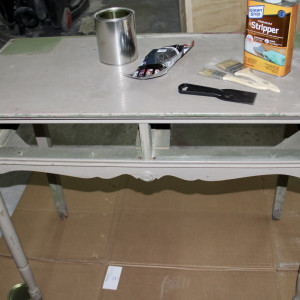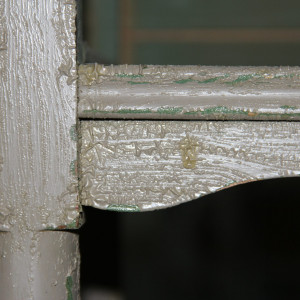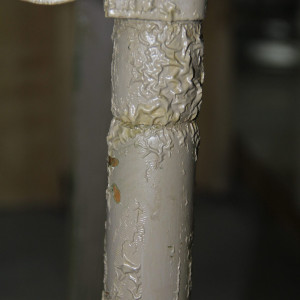Ok, now as you may recall from a previous post, we were talking about a desk we had just purchased. We thought it was a great find and that we got a deal. Turns out, the people selling the desk were the ones getting a great deal!
In fact, when we hauled the desk into the store at RepcoLite, all of our co-workers thought we were crazy! “You actually paid MONEY for that thing?!” was a question we received over and over. When we told them about our original plans to strip and stain the entire desk, they just laughed (and of course we laughed along with them because we didn’t want them to think we were dumber than we were).
As we all looked it over, we realized that our original plans had to go. We couldn’t stain the whole desk and, looking at it, we wondered if it was worth trying to stain any part of it at all. Maybe it was better to just paint the whole thing. After all, someone must have painted this little desk for a reason—were they trying to cover up something even worse than we’d already discovered? But still, there was always a chance …
Maybe, just maybe … we’d find a pleasant surprise under the paint.
Lesson Two: The Art of Being Flexible!
See, that’s the thing with refinishing old things. You have to be flexible. You have to roll with the punches. In almost every furniture refinishing project, you’ll find yourself in the same spot we did. You’ll have made glorious plans. And you’ll discover something–often many things–that completely disrupt those plans. And when that happens, you have to find a way to be flexible!
Don’t stubbornly cling to a plan just because it was the original plan! Be ready to adjust on the fly. Be willing to compromise.
And NEVER let yourself believe that the compromise is actually the lesser of the plans! What starts as a compromise can turn out better than your original intentions!
But you’ll never get there if you’re not flexible. If you’re not flexible, you’ll spin your wheels. You’ll struggle. And you’ll be disappointed. Instead, assess the situation, make a new plan, and ROLL with it!
In our situation, we had nothing to lose! We told ourselves that if the desk was painted for a reason, we’d just paint everything. We knew the legs had to be painted because of the MAJOR pieces that had to be filled in. But we held onto the hope that the top might still be stainable! Sure, the whole piece might not be a rich wood tone as we’d planned, but a stained top with everything else painted could be very cool!
Chemical Stripping or Sanding? That is the Question!
So we were back in business. Now the only question left was how to remove the peeling paint: sanding or chemical stripping?
We opted for chemical stripping. Yes, it’s stinky. Yes, it is pretty nasty to work with. Yes, it makes a mess. But it also works quickly and efficiently. And, let’s face it, we were anxious to know if our gamble was going to pay off. We also knew that if the top WAS worth staining, the image that was in our heads was of a darker stain. Using an orbital sander on a large, flat surface can leave visible swirl marks when a dark stain is applied. We definitely didn’t want that and so a chemical stripper was definitely the way to go.
Watching Chemical Stripper is More Fun Than Watching Paint Dry
So, with rubber-gloved hands and chip brushes, we began applying the Klean Strip Premium Stripper. We stood around staring at it intently. Watching chemical strippers work is WAY more fun than watching paint dry! We could actually see the old layers of paint as they crinkled and shriveled up, ready for scraping.
After about 15 minutes of careful watching, we grabbed some plastic putty knives and started scraping off the softened paint. The first layer came off like a dream. The second layer, however, refused to give up. But we were more stubborn and simply applied more stripper. We would endure the smell if it meant we would win the paint battle.
Anticipation grew as layers of paint were scraped away. For us it seemed like we waited forever, even though it was really only about an hour. Was the waiting and work worth it? Check out the next post to find out!



